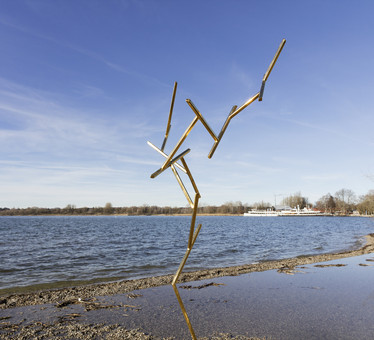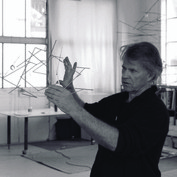Knopp Ferro

Bensberg, Germany, 1953
Among the various materials that have increased the reach of human action in the world, iron is perhaps one of the most paradoxical. Iron is tough and malleable, heavy and light, impassive and conductive. Its extraction is violent, almost always obliterates entire mountains. Its improvement includes successive changes in physical state. Finally, once combined with carbon, tungsten or zinc in the form of powerful hybrids, it performs delicate work in the hands of seamstresses and on operating tables, as well as floating, extremely heavy: it becomes a ship, plane, door -missiles, satellite. It is precisely this complex nature that we find flagrantly channeled in the poetics of Knopp Ferro, an artist whose pseudonym reveals the importance that this metal assumes in his aesthetic research.
Having an important production within the experimental context that characterized theater and performance in the 1970s, Knopp Ferro has turned since 2003 to the creation of works that constitute among themselves a game of continuous references: his drawings are like projects of his reliefs that, in turn, they are like models of objects that meet on the perceptual threshold between three-dimensionality and two-dimensionality, between sculpture and, finally, drawing. Made up of long metallic rods painted entirely in a single color – be it black, white, red, yellow or any other – they organize themselves in varied proposals for activating the space and for establishing relationships with it.
Sculptures such as E Objekt 22:14 (2015), Construction 16:34 (2016) and Fuge 18:52 (2016) are presented on defined bases. Therefore, they should not be considered as objects other than sculptures. The title of each of these works is also unrepresentative, expressing just an idea and the time it took the artist to consolidate it. Such circumstances, which tend to generate a distance from the world, confront the very appearance of the sculptures, which can still remind us of some peaceful forms: trees, scaffolding, bamboo groves in the wind. As if they were something known and about to unravel, leaving behind only a tenuous skeleton and a familiar presence, they induce a walk around their surroundings and, in this experience, reveal a space that contracts and expands as the distance grows. it takes from the work, the angle from which it is observed, the time spent with it.
Knopp Ferro’s mobiles play even more intensely with spatial awareness. In them, hundreds of sharpened shafts and in different lengths, profile themselves towards the amplitude reserved for them by the exhibition spaces, giving body to true aerial rhizomes. Great works like the mobile Linienschiff Kap 22:26 (2016) rotate very smoothly. Immersed in apparently empty space, they are like ultra-sensitive pointers indicating the presence of an ethereal substance. Observing these Iron mobiles, one experiences a three-dimensional object that continually insists on inhabiting two-dimensionality. In fact, this subtle perceptual difference between deep and flat is almost satirized in works such as the trio Yellow 21:46, Red 22:26 and Blue 18:07 (2016), in which the metal rods are fixed on colored plates composing an object of multidimensional appreciation.
These interdimensional journeys proposed by Knopp Ferro’s works take us to an area where we find the structural efforts of Antonio Bandeira and Jackson Pollock and where little difference remains between a mobile over 5 meters tall, such as Linienschiff Raum 23:14 (2013) , and a miniature drawing like Cana 18:10 (2015) or a paper relief like Messerzeichnung #57 (2008). To get back from this trip, just take a step to the side or rotate your head a little. This is, however, a very brief return, as in seconds Ferro lifts us to the next flight.
GG
